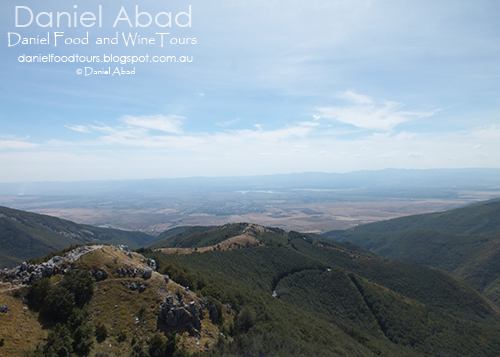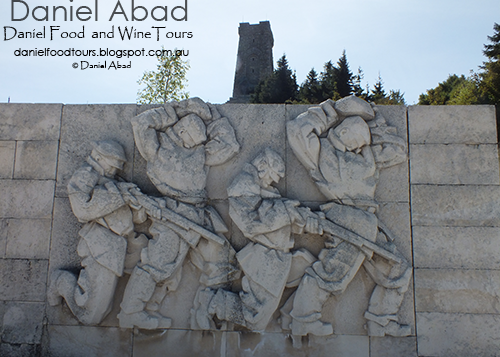For
my first excursion in Bulgaria in 2016, I visited Shipka. My friend and guide Valentin suggested that very special
place for its significance to the Bulgarian people. I had no idea of the History-changing events
that unfolded there and so was very keen to go there and learn all about it. On the way, Valentin and I spoke some more
about Shipka and what took place there. I
learnt all about the heroic events that changed the destiny of the country and
its people. I also began to appreciate the
level of respect and gratitude that the Bulgarians have for that place. This excursion had all one could wish for;
historical events, magnificent buildings, stories of heroism, endurance and
sacrifice beyond comprehension and to top it all; breath-taking views.
 |
| Valentin my Guide and Friend |
Shipka is a town in central Bulgaria in the Stara Zagora
province in the Central Balkan Mountains. At 650 metres above sea level, it has a
population of approximately 1,400 inhabitants mostly from Eastern Orthodox origin. The town is known for being located near the
historic Shipka
Pass; the location of several key battles in the Russo-Turkish war of 1877-78. These battles, collectively named the Battles
of Shipka Pass were fought between the Bulgarians, aided by Russian volunteers,
and the Ottoman Empire. Local sights
include the Russian-style Shipka Memorial Church, the Shipka Memorial on Stoletov
Peak, and the Buzludzha Monument.
 |
| The view around the Shipka Pass |
As you reach Shipka, one comes
across an amazing site. With its golden
cupolas glittering in the sun, stands the Memorial Temple of The Birth of
Christ. This Temple,
better known as the Shipka Memorial Church or Shipka Monastery is a
Bulgarian Orthodox church built between 1885 and 1902.
 |
| The Shipka Memorial Church |
A closer look at the Shipka Memorial Church golden domes...
 |
| The Golden Domes |
This memorial, together
with the other parts of the Shipka Monument complex, was built with donations from the Bulgarian people to glorify all the Russian, Ukrainian
and Bulgarian soldiers who
fell for the liberation of Bulgaria in1877-78. The names of all the Bulgarian
volunteers who fell for the liberation of this country are written with golden
letters on the monument walls.
The interior of the magnificent church...
 |
| The interior of the Skipka memorial Church |
The temple was officially opened on 28 September
1902. The opening and consecration of
the Shipka Memorial Church coincided with the 25-year anniversary of the
Battles of Shipka Pass. In 1970, the
temple was proclaimed a national monument of culture.
 |
| Another side of the church |
The church's
bell tower reaches a height of 53 m and its bells, , were cast from the
cartridges that were collected after the battles. In the temple itself, the names of the
Russian regiments and Bulgarian volunteers are inscribed on 34 marble
plates. The remains of the perished are laid in 17 stone sarcophagi in the
church's crypt.
 |
| The Church's Crypt |
 |
| The fallen... |
There
is another sacred place not far that is beloved and revered by all Bulgarians; the
Shipka peak where the National Monument of Freedom stands. The Monument stands on Stoletov Peak near the pass. A long flight of 1000 steps takes you there. There is also a short road if one doesn’t
wish to tackle the steep climb.
 |
| The National Monument of Freedom |
 |
| Some of the 1000 steps to reach the monument |
The Memorial is also dedicated
to more than 7500 Russian troops and Bulgarian volunteers
who died in the Battles, ending five whole centuries of Ottoman domination. The fighters, in temperatures as low as
minus 30 degrees, successfully repelled numerous attacks by around 38,000
Turkish soldiers. These battles changed the history of the country. The monument was opened with a
ceremony in 1934 thanks once again to the donations of the Bulgarian people. The monument symbolises the eternal aspiration
of the Bulgarian people for freedom and independence.
 |
| Carvings leading to the monument |
An artist's impression...
 |
| The Battle of Shipka |
Weapons used in the battle
 |
| Rifles from the Battle |
 |
| Pistols and Swords from the Battle |
 |
| The Bronze Lion on the Shipka National Monument of Freedom |
The monument is a 31.5-metre
high stone tower in the form of a pyramid that reminds you of
a medieval battle tower. A giant bronze lion, and a sign reading: “To all who
fought for liberty” faces east from where the liberators came. The statue is 8 m long and 4 m high and stands above the entrance to
the tower. In bronze
letters, on the other three sides are immortalised the names of the battle
fields - Shipka,
Sheynovo
and Stara Zagora.
A marble sarcophagus housing
some of the remains of 317 of the soldiers who fell during the battles is placed
on the first floor. There are four other
floors where one can find replica of Bulgarian military flags and other relics.
 |
| The Marble Sacophagus |
When you climb all floors of
the monument, you reach a panoramic ground with a striking view towards the Bulgarian Rose Valley and other sites along the Balkan Mountain Range. The view is simply majestic.
 |
| The view from the Monument |
 |
| Another view from the Monument |
There is another road that
leads from the Shipka pass to the remote summit of Buzludzha, 12 km to the east at
an altitude of 1,440 metres. The
Buzludja peak is also part of the National Park- Museum Shipka-Buzludzha. On the peak, stands an unusual abandoned
monument. Formally known as the House Monument of the Bulgarian Communist Party, it looks like something out of a 1950s-science
fiction movie. The sheer size of the
monument is staggering. The bizarre
contours of its design, create an unsettling feeling when standing in the
shadow of this concrete monster.
 |
| The Buzludzha Monument |
 |
| Approaching the Monument |
Halfway
up the mountain lies a huge sculpture showing two boulder-sized fists, each
clutching a flaming torch. The monument itself
sits at the top of a long flight of steps, looking down over a paved courtyard. It was here that the Party faithful would
have gathered for rallies and public addresses during the communist rule of the
country.
 |
| The two fists and the Flame |
This ideological monument
from the Bulgarian Socialist period was opened in 1981on the same place where
in 1891 the Bulgarian Workers’ Social Democratic Party; a forerunner of the Bulgarian Communist Party
was established, which later governed the country for 45 whole years. During the height of Soviet influence, the government decided
to erect a monument to celebrate both the country’s liberation from Ottoman rule, and the
1944 victory against Hitler’s fascist domination of Bulgaria: both events in
which Russia played a key role.
 |
| General view of the Place |
Work on the monument began in
1974, and was undertaken by units of the Bulgarian Army assisted by numerous
artisans responsible for the large statues and murals. The
saucer stands along a 107-metre tower.
The Soviet star which adorns the top of the tower is three times larger
than the one at the Kremlin; and it was claimed that the red light it emitted
could be seen from as far away as Romania in the north, and the Greek border in
the south. More than 60 Bulgarian
artists collaborated on the design of murals for the site, and thousands of
volunteers were involved in the construction process. Large images of
Lenin and Marx looked over the arena built for state functions and
celebrations. Opened in 1981. The Monument exemplifies the style common to
many state-constructed communist buildings.
At the time, it was built at a cost of 15 million Leva; equivalent to 8
million euros. The money was raised from citizens in the form of suggested donations
with the intention of creating a monument for the people, and by the people.
 |
| The enormity of the structure |
After the government’s fall
from power in 1989, the Buzludzha monument
was inherited by the State. The site was abandoned and is sinking into decay since the mid-1990s. The building has been ransacked and left open to vandalism. The roof of the building is heavily damaged
and the main entrance has been sealed and closed to public. Inside, most of the artwork has been removed
or destroyed, but the concrete structure still stands. No apparent plans are in place to renovate the
building or surrounding area with little interest still being expressed by the
present government to maintain this monument of the past. The
site has become one of the world’s most famous modern ruins attracting an increasing number of photographers and
foreign fans of the so-called dark tourism.
Recent reports indicate that
the interior of the building is no longer accessible and that local law
enforcement is preventing access inside, for safety reasons. There are no restrictions on seeing or
photographing the monument’s exterior.
 |
| The building is in bad shape |
It might be
hard to envisage a future for this reminder of the Bulgarian Communist Party. The damage, the vandalism, looting, and the
work of the elements seem almost irreparable. There are, nevertheless, those who would like
to see the Monument returned to its former glory as a testimony of the
country’s history and for what it’s worth, I agree with this thinking. I however have never experienced Life under a
communist regime and so it’s easy for me, as a visitor to this country, to separate
the monument from its meaning. For the Bulgarians
who lived in its shadow and came to regard Buzludzha as the symbol of a regime
associated with pain and suffering, the separation and acceptance of this part
of their recent history may well be somewhat more difficult to come to terms
with. For some young Bulgarians however, especially those
born after the fall of communism, exploring the UFO might just be a way to
understand their country’s history. Perhaps for many, it would be preferable after all to
simply “Forget Your
Past”, as one the graffiti on one of the outside walls of the
building suggests.
 |
| Some of the Graffiti |
After this physically
challenging and emotionally charged day, it was time to sample the local
foods. Valentin suggested the Old House
Restaurant at Enina, not far from Buzludzha. His choice was perfect. The restaurant mostly catering for the locals
and a few visiting tourists sits in a quiet street and unless you knew where it
is, you would simply not find it. I
enjoyed the tranquility of the place and its typical décor made it that much
more enjoyable.
 |
| The dining area |
 |
| The Old House Restaurant |
Although it was way past the lunchtime service time; more like 4.00 PM,
the restaurant Staff welcomed us and treated us to some very tasty dishes. We started the meal with the traditional
salad which in most instances is eaten with a shot of Rakia, the Bulgarian
equivalent of Schnapps. We settled for a
cold Zagorka, one of the local beers.
We followed the salad by some grilled sausages, a meat dish cooked with
fresh mushrooms in a sauce that was simply delightful and some flat bread. We didn’t have any room left for dessert.






























No comments:
Post a Comment